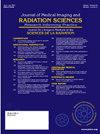脊柱手术中辐射暴露的系统回顾和荟萃分析:比较c臂、CT导航和o臂技术。
IF 1.3
Q3 RADIOLOGY, NUCLEAR MEDICINE & MEDICAL IMAGING
Journal of Medical Imaging and Radiation Sciences
Pub Date : 2024-12-31
DOI:10.1016/j.jmir.2024.101831
引用次数: 0
摘要
先进的成像技术,如c臂透视,o臂,和CT导航,是不可或缺的,以实现精度在骨科手术。然而,这些技术也使病人、外科医生和手术室工作人员暴露在不同程度的辐射下。本系统综述和荟萃分析评估了与这些成像方式相关的辐射暴露(RE)及其对手术结果的影响。方法:根据PRISMA指南进行全面的文献检索,得到2725篇确定的文章。在去除重复项和筛选合格性后,24项研究被纳入分析。辐射暴露数据以毫西弗(mSv)和毫雷(mGy)计量,使用换算公式进行标准化。使用纽卡斯尔-渥太华量表(NOS)和ROB2工具进行质量评估。统计分析采用随机效应模型比较辐射暴露和固定效应模型的次要结果。结果:meta分析包括11项研究:8项研究比较c臂和CT导航技术,3项研究比较c臂和o臂技术。分析显示,与c臂相比,CT导航与更高的RE相关(标准化平均差(SMD): 4.73, 95%可信区间(CI): 2.44 ~ 7.03;P < 0.0001)。相比之下,o型组和c型组的RE无显著差异(SMD: 1.34, 95% CI: -0.17 ~ 2.85;P = 0.082)。二次分析显示,CT导航和c臂技术在手术时间和住院时间上没有显著差异。讨论:本荟萃分析的结果强调了辐射暴露与手术精度之间的权衡。虽然与c臂透视相比,CT导航显着提高了RE,但它提供了更高的准确性,特别是在关键的精密手术中,如脊柱介入手术。o型臂技术和c型臂技术在RE方面没有显著差异,这表明o型臂技术可能提供了一种平衡的方法,在辐射水平与c型臂相似的情况下提供了更高的准确性。然而,研究之间的显著异质性和次要结果的不一致报告表明需要进一步研究。未来的研究应侧重于改进成像技术,以优化辐射安全和手术准确性之间的平衡。结论:与CT导航相比,c臂成像通常导致更低的辐射暴露,使其更适合于对极端精度不那么重要的标准程序。然而,CT导航优越的精度证明了它在精确手术中的应用,尽管辐射暴露较高。o型臂技术具有与c型臂相当的RE和更高的精度,在可用的情况下是一种有益的选择。正在进行的研究应旨在优化成像技术,平衡辐射安全和手术精度的需求。本文章由计算机程序翻译,如有差异,请以英文原文为准。
A systematic review and meta-analysis of radiation exposure in spinal surgeries: Comparing C-Arm, CT navigation, and O-Arm techniques
Introduction
Advanced imaging techniques, such as C-arm fluoroscopy, O-arm, and CT navigation, are integral to achieving precision in orthopedic surgeries. However, these technologies also expose patients, surgeons, and operating room staff to varying levels of radiation. This systematic review and meta-analysis evaluate the radiation exposure (RE) associated with these imaging modalities and their impact on surgical outcomes.
Methods
A comprehensive literature search was conducted following PRISMA guidelines, resulting in 2,725 identified articles. After removing duplicates and screening for eligibility, 24 studies were included in the analysis. Radiation exposure data, measured in milliSieverts (mSv) and milliGray (mGy), were standardized using conversion formulas. Quality assessments were performed using the Newcastle-Ottawa Scale (NOS) and ROB2 tools. Statistical analysis was conducted using random-effects models for comparing radiation exposure and fixed-effects models for secondary outcomes.
Results
The meta-analysis included 11 studies: 8 studies comparing C-arm and CT navigation, and 3 studies comparing C-arm and O-arm technologies. The analysis revealed that CT navigation is associated with significantly higher RE compared to C-arm (Standardized Mean Difference (SMD): 4.73, 95% Confidence Interval (CI): 2.44 to 7.03; p < 0.0001). In contrast, there was no significant difference in RE between O-arm and C-arm (SMD: 1.34, 95% CI: -0.17 to 2.85; p = 0.082). Secondary analyses showed no significant differences in surgery duration or hospitalization length between CT navigation and C-arm techniques.
Discussion
The results of this meta-analysis underscore the trade-offs between radiation exposure and surgical precision. While CT navigation significantly increases RE compared to C-arm fluoroscopy, it offers superior accuracy, particularly in critical precision surgeries such as spinal interventions. The lack of significant difference in RE between O-arm and C-arm technologies suggests that O-arm may provide a balanced approach, offering enhanced accuracy with radiation levels similar to C-arm. However, the significant heterogeneity among studies and inconsistent reporting of secondary outcomes indicate the need for further research. Future studies should focus on refining imaging techniques to optimize the balance between radiation safety and surgical accuracy.
Conclusion
C-arm imaging generally results in lower radiation exposure compared to CT navigation, making it preferable for standard procedures where extreme precision is not as critical. However, CT navigation's superior accuracy justifies its use in precision surgeries despite the higher radiation exposure. O-arm technology, with its comparable RE to C-arm and enhanced accuracy, represents a beneficial option where available. Ongoing research should aim to optimize imaging techniques, balancing the need for radiation safety with the demands for surgical precision.
求助全文
通过发布文献求助,成功后即可免费获取论文全文。
去求助
来源期刊

Journal of Medical Imaging and Radiation Sciences
RADIOLOGY, NUCLEAR MEDICINE & MEDICAL IMAGING-
CiteScore
2.30
自引率
11.10%
发文量
231
审稿时长
53 days
期刊介绍:
Journal of Medical Imaging and Radiation Sciences is the official peer-reviewed journal of the Canadian Association of Medical Radiation Technologists. This journal is published four times a year and is circulated to approximately 11,000 medical radiation technologists, libraries and radiology departments throughout Canada, the United States and overseas. The Journal publishes articles on recent research, new technology and techniques, professional practices, technologists viewpoints as well as relevant book reviews.
 求助内容:
求助内容: 应助结果提醒方式:
应助结果提醒方式:


